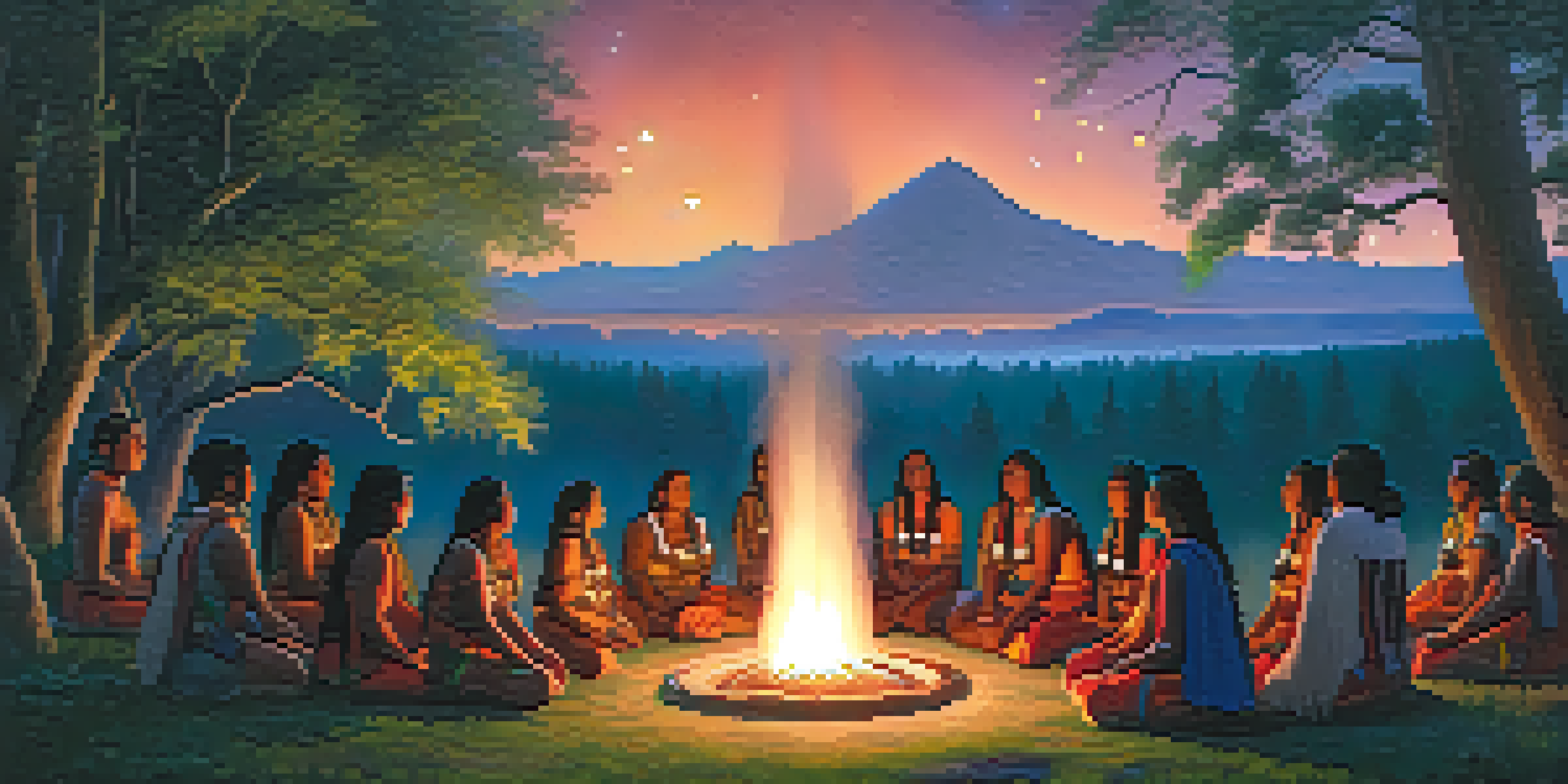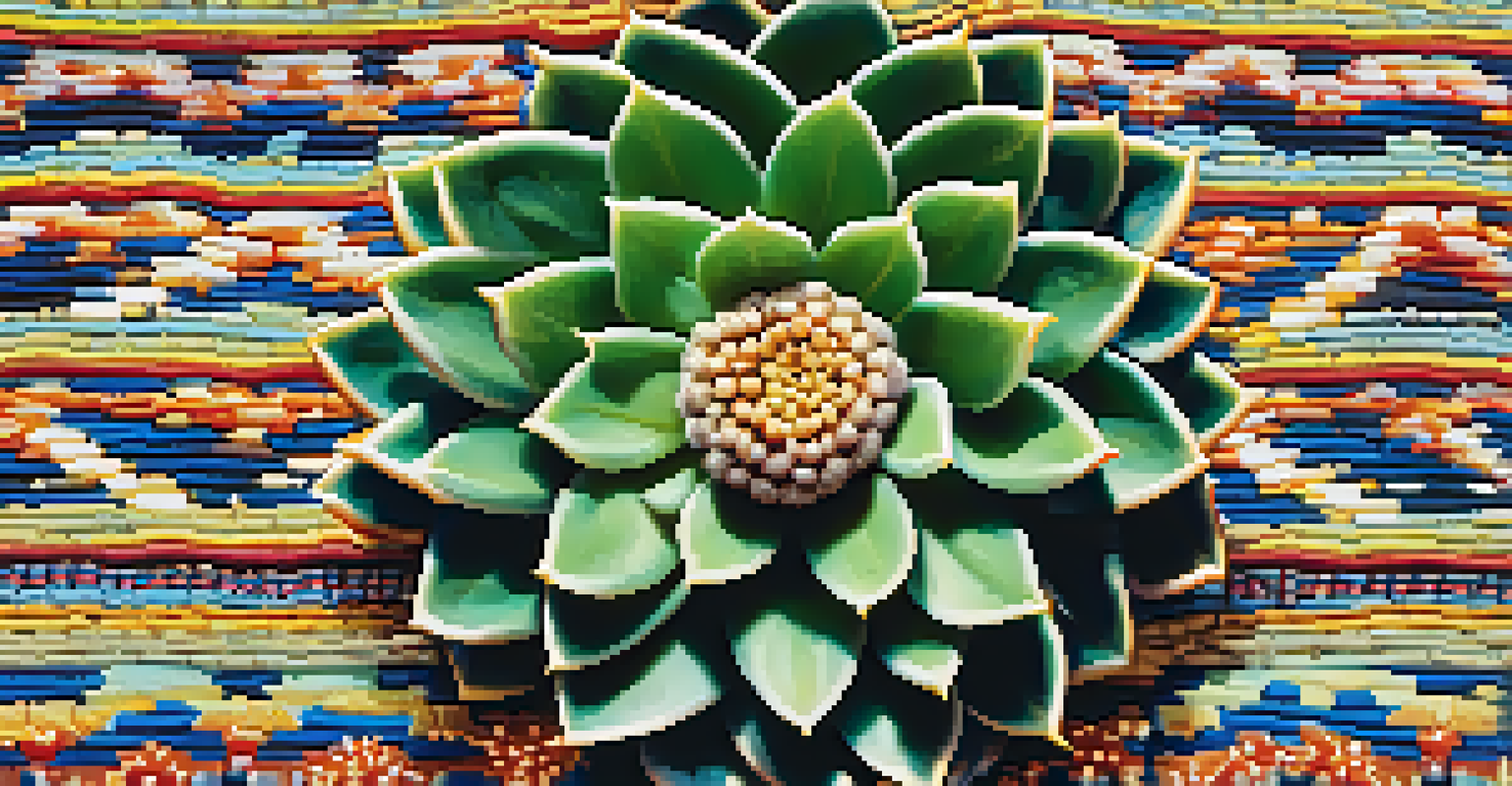Cultural Narratives: Entheogens' Role in Indigenous Stories

Understanding Entheogens in Indigenous Cultures
Entheogens, often referred to as psychoactive substances, play a crucial role in Indigenous cultures. These natural substances, such as peyote and ayahuasca, are used in spiritual ceremonies to facilitate deep connections with the divine. They’re not just recreational; these experiences are woven into the fabric of cultural identity and storytelling.
The use of entheogens is a sacred gift from nature that allows us to connect deeply with our spiritual selves and the universe around us.
For Indigenous peoples, the use of entheogens is often tied to their cosmology and worldview. These substances help bridge the gap between the physical and spiritual realms, providing a means to access knowledge and wisdom passed down through generations. This deep-rooted relationship emphasizes the respect and reverence these communities hold for nature and its gifts.
By engaging with entheogens, Indigenous narratives often convey lessons about life, community, and the universe. These stories are not only shared orally but are also expressed through art, music, and rituals, enriching the cultural landscape and ensuring the continuity of Indigenous traditions.
Cultural Significance of Entheogens in Rituals
Rituals involving entheogens serve as a rite of passage and a means of communal bonding. For instance, in the Native American Church, peyote ceremonies bring individuals together to connect with each other and the spiritual world. These gatherings foster a sense of belonging and reinforce community values.

During these rituals, participants often share personal stories and insights gained from their experiences. This storytelling aspect is vital, as it allows for the transmission of wisdom and cultural teachings to younger generations. It turns individual experiences into collective narratives that strengthen cultural ties.
Entheogens in Indigenous Spirituality
Entheogens are integral to Indigenous cultures, facilitating spiritual connections and reinforcing cultural identity.
Moreover, the use of entheogens in rituals helps to affirm cultural identity amidst the pressures of modernization. They serve as a reminder of the importance of tradition and the interconnectedness of all life, promoting resilience and continuity in Indigenous cultures.
Entheogens as Tools for Healing and Transformation
For many Indigenous communities, entheogens are viewed as sacred tools for healing. They are believed to facilitate emotional and spiritual healing, allowing individuals to confront trauma and find clarity. This therapeutic potential has attracted attention beyond Indigenous cultures, sparking interest in their benefits.
Storytelling is the heartbeat of our culture, weaving our experiences, teachings, and the sacred into a tapestry that binds us together.
Incorporating entheogens into healing practices often involves guidance from a spiritual leader or shaman. This mentorship is crucial, as it ensures that the experiences are safe and meaningful. Participants are encouraged to reflect on their journeys, fostering personal growth and understanding.
As awareness of mental health challenges grows, the transformative power of entheogens is gaining recognition in broader contexts. This intersection of traditional wisdom and modern therapeutic practices illustrates the potential for healing rooted in Indigenous narratives and practices.
The Role of Storytelling in Indigenous Wisdom
Storytelling is a cornerstone of Indigenous knowledge transmission, often intertwined with the use of entheogens. These narratives encapsulate the values, beliefs, and histories of communities, making them a vital part of cultural identity. Each story told during ceremonies serves to reinforce the teachings learned through entheogenic experiences.
Through storytelling, complex ideas about existence, morality, and the environment are conveyed in relatable ways. Metaphors and allegories are often employed, allowing listeners to connect personally with the lessons. This approach makes the wisdom accessible, ensuring it resonates deeply within the community.
Healing and Transformation Tools
Indigenous communities view entheogens as sacred tools for emotional and spiritual healing, promoting personal growth.
As Indigenous peoples face challenges from globalization, storytelling remains a powerful tool for preserving culture. By sharing their stories, they not only honor their ancestors but also empower future generations to carry on their legacy.
Interconnectedness of Nature and Spirituality
A prominent theme in Indigenous narratives is the interconnectedness of nature and spirituality, often highlighted during entheogenic experiences. These narratives emphasize that all beings are part of a larger web of life, reinforcing the belief that nature is sacred. This perspective fosters a deep respect for the environment, leading to sustainable practices.
Entheogens are seen as a bridge to understanding this interconnectedness. When individuals partake in these substances, they often report profound realizations about their place in the universe. This connection to nature reaffirms the importance of stewardship and responsibility towards the Earth.
By integrating these teachings into their cultural narratives, Indigenous peoples advocate for environmental conservation. Their stories remind us that the health of the planet is intricately linked to our spiritual well-being, urging us to honor and protect the natural world.
Entheogens and Indigenous Identity in Modern Society
In contemporary society, the role of entheogens in Indigenous identity is increasingly significant. As Indigenous communities navigate the complexities of modernization, these substances offer a way to reconnect with ancestral traditions and values. They serve as symbols of cultural resilience and continuity.
The resurgence of interest in entheogens has led to a broader appreciation for Indigenous practices. This resurgence is not only about the substances themselves but also about the rich cultural narratives surrounding them. By sharing their stories, Indigenous peoples invite others to learn and respect their heritage.
Protecting Cultural Narratives
Storytelling and the use of entheogens empower Indigenous peoples to preserve their heritage and advocate for environmental stewardship.
However, it's crucial that this interest is approached with sensitivity and respect. Indigenous communities must be empowered to share their narratives on their terms, ensuring that their wisdom and traditions are honored and preserved.
Challenges and Misunderstandings Surrounding Entheogens
Despite their cultural significance, entheogens often face challenges and misunderstandings, especially in Western contexts. Misappropriation and commercialization can dilute their sacred meanings, reducing them to mere recreational substances. This commodification undermines the deep spiritual and cultural practices associated with their use.
Additionally, the legal status of entheogens can create barriers for Indigenous communities. While some regions are beginning to recognize their traditional uses, others maintain strict prohibitions based on misconceptions. This legal landscape complicates the ability of Indigenous peoples to practice their traditions freely.

Addressing these challenges requires education and advocacy. By fostering dialogue and understanding, we can work towards a more respectful appreciation of entheogens and the rich cultural narratives they embody.